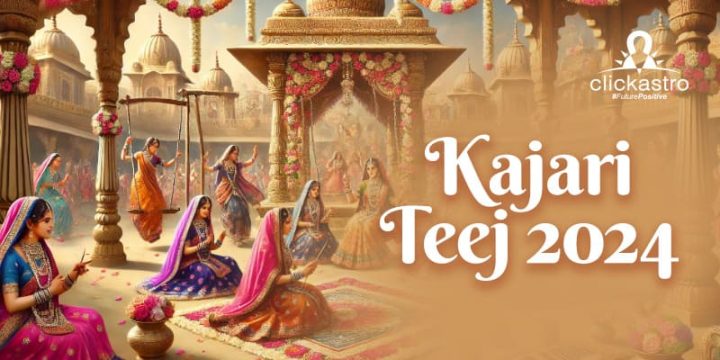In India, marriage is a sacred institution, and any ceremony or rituals that are associated with marriage and the longevity of marriage is highly auspicious. One such festival that is associated with marriage and the longevity of conjugal bliss is the festival of Teej. During the Teej festival, married women observe a strict fast throughout the day for the long life of their husbands. Unmarried girls also observe this fast to pray for a worthy husband. The festival of Teej signifies the devotion of the wife towards her husband.
Get Your Free Marriage Predictions
Various Teej festivals are celebrated throughout the year –
Hariyali Teej, Kajari Teej, and HartalikaTeej. Kajari Teej is also popularly known as Kajli Teej, Badi Teej, Budhi Teej, and Saturi Teej and is celebrated on the third day of the
Krishna Paksha in the month of Bhadrapada, which corresponds to August or September according to the
Gregorian calendar. Along with the above Teej festivals, women also observe Akha Teej, which is otherwise popularly known as
Akshaya Tritiya. The term Teej denotes the third day after the
new moon or Amavasya and
full moon or Purnima. Kajari Teej is celebrated with great fervor and pomp in the northern states of India, such as Rajasthan, Bihar, Uttar Pradesh, Madhya Pradesh, and Punjab. The Kajari Teej festival is observed to worship Goddess Parvathi in the Teej Matha and the neem tree, which is also known as Neemdi Mata.
When is Kajari Teej 2024?
Kajari Teej 2024 will be celebrated on Thursday, 22nd August.
Trithiya
Tithi timings are as follows:
- Tritiya Tithi Begins at 5:07 pm on August 21, 2024
- Tritiya Tithi Ends at 1:46 pm on August 22, 2024
Significance of Kajari Teej
Kajari Teej festival celebrates the spirit of womanhood and pray for the prosperity and long life of husbands as well as the safety and wellbeing of offspring. Married women observe this festival with great enthusiasm and gaiety. The festival also welcomes the beginning of the monsoon, which comes as a relief from the scorching heat of the summers. The monsoon season heralds prosperity and excitement. All the Teej festivals are observed during the Shravan month. Kajari Teej endorses the uniqueness of Indian culture, and while it is celebrated for two consecutive days, the essence of the festival lasts long through the
Janmashtami celebrations.
Kajari Teej Puja Vidhi
On Kajari Teej, the women wake up early before sunrise and eat some food before sunrise. They then spend the whole day without eating or drinking a drop of water. The Kajari Teej Puja is performed in the evening with the fall of dusk on Kajari Teej and is the most important part of the fasting. Traditionally, some married women may choose to observe this fast at their maternal homes. The Puja Vidhi also has variations from state to state. The Sattu (roasted gram flour) is an important part of the Pooja and comes from the maternal home of married women. The Sattu is mixed with ghee and sugar and rolled into small balls or Pind. This Sattupind is worshipped during the Pooja.
Get Marriage Compatibility Report
In some regions, the neem tree is worshipped and is represented by a neem tree twig with leaves. The puja is initiated by worshipping Lord Ganesha by offering flowers, kumkum, kajal, mehndi and sweets and bhog prepared for the Lord. A small well-like dent is made with clay or mud on the Pooja platform, and the neem tree twig with leaves is then planted in one corner of this clay well. An offering of raw milk (not boiled) and water is then poured into this well to fill it up. The neem twig representing Neemdi Mata is then offered, followed by Kumkum, Akshat (unbroken rice), kajal and Mehndi and then a red chunri. Kumkum, Kajal and mehndi are applied to the four corners of the Pooja platform.
The women look into the well filled with milk and water to see the reflection of the puja items like the oil lamp made from Sattu ball, lemon, cucumber, etc. The final step is to worship Neemdi Mata and Goddess Parvathi with pure devotion and listen or read the Kajari Vrat Katha and the Neemdi Mata Katha to conclude the Pooja rituals. Women break the fast only after seeing the moon and worshipping the Moon (Chandra dev) and feeding the cow.
How do we celebrate Kajari Teej – Customs and Rituals
Kajari Teej is known as Badi Teej since it follows the Hariyali Teej, which is known as Choti Teej. Kajari Teej is the most important Teej for married women. The festival is celebrated in different ways in different states. In Varanasi, Mirzapur, and Madhya Pradesh, Kajari Teej is celebrated with great pomp and is a colorful festival. Women dress up in beautiful bridal finery in bright coloured dresses, jewellery and apply mehndi on their arms and feet just like a bride. They observe fast and conduct rituals throughout the day.
Parents of married women follow the custom of presenting new clothes, jewellery, and other symbolic items of a married woman as well as roasted gram flour (sattu) to their daughters as they observe the Kajari Teej fast. This festival celebrates womanhood and the dedication and power of women in ensuring the long life of their husbands and the safety of their offspring.
Download Free Couple’s Horoscope
Kajari Teej falls in the months of August-September during the monsoon season. Women endure even the rough weather and celebrate this fast with great enthusiasm and devotion. Beautiful swings decorated with flowers are hung from the trees, and since this festival is for married women, they spend the day together swinging, singing the folk songs of Kajari of longing and separation, dancing, and participating in all the cultural activities in the true spirit of the festival. In Rajasthan, fairs are organized, and women celebrate the day with their family members.
While the festival is celebrated with great pomp, women also follow the ritual meticulously. Women wake up early in the morning, and after completing their morning tasks, they take a Sankalp to spend the day fasting till the evening. At dusk, they break their fast after performing the Kajari Teej Pooja, worshipping Goddess Parvathi and Lord Shiva and Neemdi Mata and listening/reading to the Kajari Teej vrat katha.
Women prepare special delicacies for Kajari Teej, some of which include Kheer, Puri, badam ka halwa, Gujiya, Ghevar, and Kaju Katli, to name a few. Sattu is a sweet preparation made from roasted gram flour, ghee, and sugar and is of great significance during the rituals and celebrations of Kajari Teej. These special offerings are prepared and offered to Goddess Parvathi and then later distributed among family and friends. There is also a tradition of gifting “Shringara” items to married women, which includes clothes, jewellery, and sweets on Kajari Teej.
Legend of Kajari Teej
Many stories are associated with Kajari Teej; however, a couple of them are remarkable for their significance with this festival. Legend has it that somewhere in Central India, there was a magnificent kingdom by the name of Kajali, which was ruled by King Dadurai. The people of Kajali used to sing songs called Kajali in praise of this magnificent kingdom. The demise of King Dadurai and his wife Queen Nagamati performing Sati became a pivotal point in the life of the people of Kajali, who were saddened by the unfortunate turn of events. They composed songs improvising Raga Kajari, which were originally songs of separation, longing for the lover and to date, women observing the Kajari Teej fast sing this popular folklore as part of the ritual of Kajari Teej.
Another mythological story associated with Kajari Teej is that of Goddess Parvathi and Lord Shiva. Kajari Teej is also celebrated to worship Goddess Parvathi. It is a belief that Goddess Parvathi desired to marry Lord Shiva, who was an ascetic. She was so determined in her desire that she performed strict and rigorous penance for 108 years. Seeing Goddess Parvathi’s dedication and focus, Lord Shiva was pleased with her and accepted a divine union with her. The divine union of Lord Shiva and Goddess Parvathi took place during Krishna Paksha of the Bhadrapada month, which later came to be known as Kajari Teej. It is, therefore, considered auspicious to worship Goddess Parvathi and Lord Shiva during Kajari Teej.
In some parts of India, women also worship the Neem tree or Neemdi Mata, as they are popularly known along with the worship of Goddess Parvathi. It is a belief that worshipping Neemdi Mata blesses the women with worthy offspring as well as the bliss of a happy marital life. This Kajari Teej fast is therefore not just associated with marital bliss but also endows the wellbeing and safety of their offspring.
Kajari Teej Vrat and Neemdi Mata Vrat Katha
Reading and listening to the Kajari Teej Vrat Katha is an important part of the Pooja ritual. Women gather around after offering worship to goddess Parvathi, and the elder women in the family or the group reads out the Kajari Teej while the younger girls and married women listen to them. In some regions, women also read the Neemdi Mata Vrat Katha along with the Kajari Teej Vrat Katha. The story is as follows:
Kajari Teej Vrat Katha
In a village lived a poor Brahmin along with his wife, who was observing the Kajari Teej. The Brahmin’s wife did not have anyone in her maternal home who would send her the Sattu as per the ritual, so she asked the Brahmin to get the Sattu for her Pooja ritual. The evening had already set in, and the Brahmin was helpless as he did not know how to get the Sattu and return before the Pooja commenced. The Brahmin’s wife, however, was insistent, and he had no choice but to go out in search of Sattu, but he could find the Sattu nowhere.
He was worried that his wife will be dejected and would not be able to complete her Pooja ritual. As he searched, he saw a grocery store and entered the store stealthily. He could not find the Sattu inside, so he took one and a quarter kilo of a gram (chana) and ground it into a powder. He then mixed it with ghee and sugar and was about to leave when the shop owner’s servant mistook him for a thief.
Hearing the commotion, the shop owner, who was also a moneylender, asked the frightened Brahmin what he had stolen. The Brahmin confessed that he was a poor man and told him why and what he had done. He added that except for the Sattu, he did not steal anything from the store and that stealing was not his intention. When the servant checked the Brahmin, he found that the Brahmin was telling the truth. The shopkeeper understood the intentions of the Brahmin and let him go as the moon had already risen, and it was getting late for him.
The shop owner told the Brahmin that from that moment onwards, he would consider the Brahmin’s wife as his sister. He gave the Brahmin new clothes, ornaments, kajal, mehndi and money along with Sattu and promised to send this every year. The Brahmin went home with the Sattu and presents. His life changed, and he became prosperous and led a happy life. Thus, observing the Kajari Teej helped one to change the life of the devotees to that of prosperity and abundance.
Neemdi Mata Vrat Katha
There once lived a wealthy couple who had no children. The businessman’s wife longed for a child and observed the Kajri Teej fast and prayed to Neemdi Mata that if she were blessed with a child, she would offer Sattu of a quarter of a man to Neemdi Mata. The lady was blessed with a son in the ninth month; however, she forgot her promise and did not offer Sattu to Neemdi Mata.
As time went on, she gave birth to six more sons; however, she still did not keep her word and forgot all about her offerings. When her first son got married, he died due to a snake bite on the night of the marriage. One after another, her six sons died on the night of the wedding itself. Seeing this, the couple decided that they would not marry their seventh son. But after much persuasion of the family and villagers, they decided to get their seventh son married in a distant country.

The businessman set out in search of a bride for his son, and on his way, he saw a group of girls playing. They were building small earthen houses and breaking them. However, one girl refused to break her earthen house, and the businessman felt she was the right girl for his son. He followed the girl to her house and asked her hand in marriage for his son. His son was married to the girl, and the procession back to the businessman’s home was a long way off. Since they had set off on the journey on Kajari Teej day, the girl’s mother gave her Sattu and offered her advice.
She instructed the girl to worship Neemdi Mata in the evening along the way and read the story of Neemdi Mata. She asked her daughter to offer Sattu to Neemdi Mata and only then break her fast and carry some Sattu for her mother-in-law. On the way, when her father-in-law asked her to eat, she said that she was observing the Kajari Teej fast and would only break her fast after offering worship to Neemdi Mata and listening to the vrat katha of Neemdi Mata.
As dusk set in, the businessman stopped the procession when he saw a Neem tree near a well. The girl worshipped the neem tree and offered worship to Neemdi Mata. As she was worshipping, Neemdi Mata retreated. She asked – Oh mother, why are you angry? Did I do any wrong? Neemdi Mata then told her the story of her mother-in-law, who forgot to keep her promise of offering Sattu. The girl pleaded with Neemdi Mata to forgive her mother-in-law and that she would offer Sattu to Neemdi Mata in place of her mother-in-law.
She also prayed to bring all her brothers-in-law back to life and let her worship Neemdi Mata. Neemdi Mata was pleased by the devotion and reverence of the girl and granted her wish. The girl worshipped Neemdi Mata and offered aaradhya to the moon. She offered Sattu to Neemdi Mata and broke her fast. The marriage procession then resumed its journey back to the businessman’s house.
Upon reaching the house, when the girl entered her in-laws’ house, all her brothers-in-law appeared. The mother-in-law thanked the girl, and the girl told her the entire story and asked her mother-in-law to rectify her mistake and offer Sattu to Neemdi Mata. Twelve months later, on Kajari Teej day, all the daughters-in-law, along with the mother-in-law, worshipped and offered Sattu to the equivalent of seven and a half men to Neemdi Mata. Thus, Kajri Teej is also observed not just for marital bliss and longevity of husbands but also for the safety and wellbeing of offspring.









